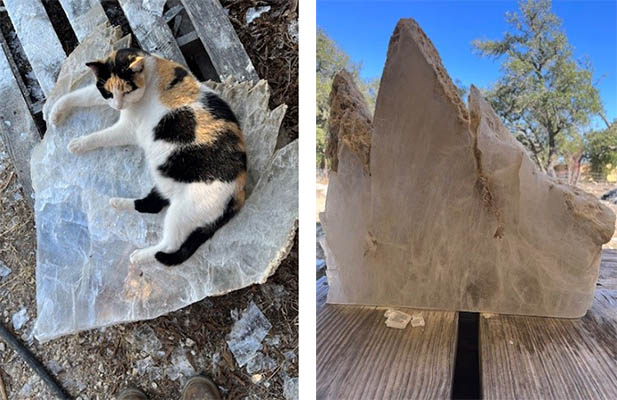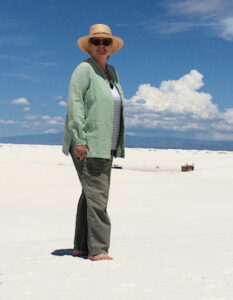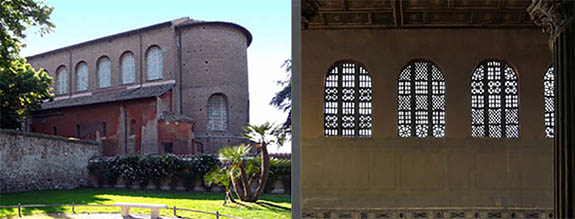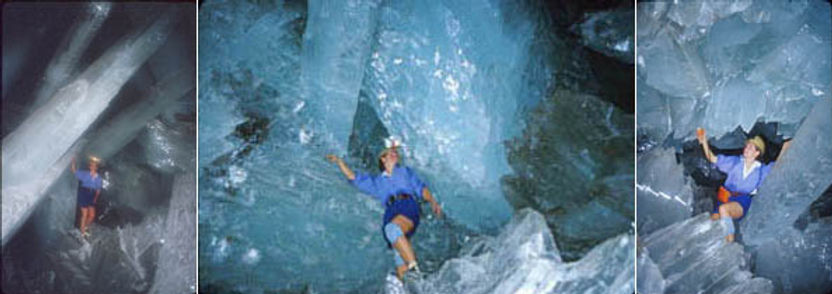Tests in a sophisticated lab at a major university have shown that when liquids, in glass containers, are placed on our selenite crystal, the chemical composition of the liquid (wine, beer, and coffee tested so far) is changed. Think about it… selenite crystal changes the chemical composition of liquids. And how many forms or types of liquids, or things containing liquids? After all, humans are 70% liquid! In more recent laboratory tests, we have confirmed that selenite will change a persons blood chemistry, for the better. More to come on this later.
We have discovered, and tested, an invisible, environmentally green nanotechnology treatment for porous materials that resists stains and water damage. It is a surface treatment stabilizer, a liquid, water-based, organic treatment that is applied to porous surfaces. We applied it on a rough slab of selenite and then poured cherry juice concentrate on the slab and left it overnight. the next morning we washed off the cherry juice and none had seeped into the rough slab! An extreme test! Contact us for info if you want your outdoor slab or table slab treated.
We have recently discovered a new form of selenite that has grown in a clay formation rather than a gypsum environment. The closest form of selenite to it is “duckbill” found in Canada; however, the “duckbill” is tiny by comparison. Here is one example of the “Dragons Tooth©”

Tests in Korea have shown that our selenite crystal produces 800-1000 negative ions per cubic centimeter of surrounding air. A pristine forest produces about 400 negative ions per cubic centimeter. WebMD says:
“Negative ions are odorless, tasteless, and invisible molecules that we inhale in abundance in certain environments. Think mountains, waterfalls, and beaches. Once they reach our bloodstream, negative ions are believed to produce biochemical reactions that increase levels of the mood chemical serotonin, helping to alleviate depression, relieve stress, and boost our daytime energy.”http://www.webmd.com/balance/features/negative-ions-create-positive-vibes
Most recently, tests have shown our selenite crystal to have a frequency of 244.5 MHZ, whereas, our selenite powder is at 233 MHZ.
“A healthy body frequency is 62-72 MHZ . When the frequency drops, the immune system is compromised. Essential oils start at 52 MHZ and go as high as 320 MHZ, the frequency of rose oil.”
The only essential oil with a higher frequency than selenite, is rose oil.
Tests have shown that Selenite should never be stored or placed on concrete or cement floors or foundations. This includes thin tiles or carpet or linoleum on top of such foundations. This will drain the selenite! Place at least one inch of wood or natural stone between the selenite and such surfaces. Email us if your selenite has been drained by storage on cement or concrete.

The word “selenite” comes from the Greek “selenites,” meaning “moon stone” or “moon rock,” with the root word “selene” meaning “moon,” and for good reason – the mineral selenite is the near transparent and colorless crystal form of gypsum that exudes a pearly luster which glows and can very much resemble the moon. Selene is also the name of the Greek Goddess of the Moon (a.k.a. Artemis or Diana).
https://www.controverscial.com/Selenite.htm
Selenite is a form of gypsum, CaSO4-2(H2O), hydrated calcium sulfate. Gypsum is one of the more common minerals in sedimentary environments. It is a major rock forming mineral that produces massive beds, usually from precipitation out of highly saline waters.
https://www.galleries.com/minerals/sulfates/gypsum/gypsum.htm
Gypsum is found as both massive material, including the alabaster variety; and clear crystals, the selenite variety; and parallel fibrous, the satin spar variety.
https://www.mindat.org/min-1784.html
The largest visible deposit of selenite is in the form of sand crystals at White Sands National Monument in New Mexico, where the selenite sand covers an area of 275 square miles. https://www.nps.gov/whsa/learn/gypsum.htm


Santa Sabina is the oldest extant Roman basilica in Rome. Santa Sabina was built by Peter of Illyria, a Dalmatian priest, between 422 and 432. The exterior of the church, with its large windows made of selenite, not glass, looks much as it did when it was built in the 5th century.
http://en.wikipedia.org/wiki/Santa_Sabina
The largest individual selenite crystals have been found in Mexico’s Cueva de los Crystales, also known as the Cave of the Crystal Giants, deep under the Naica Mountain in the Chihuahuan Desert. The largest single crystal is 4 feet in diameter, 50 feet long, and weighs over 55 tons.
These photos were taken in the Cave of the Crystal Giants in Mexico (http://www.thecrystalgiants.com/), and show one of the earliest explorers, Leela Hutchison.
Leela is a major supporter of Selenite.